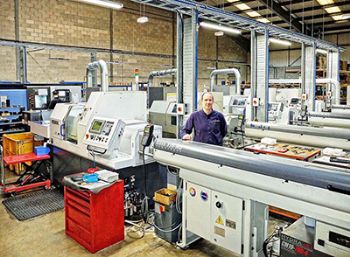
Since moving premises in Bicester at the beginning of 2015, sub-contractor SRD Engineering has almost trebled its turnover and head-count.
Moreover, the company’s rate of growth increased during 2018, following the installation of three new sliding-head CNC turning centres from Citizen Machinery.
Joining a 20mm bar capacity Citizen Cincom L20 Type VII lathe installed in 2009, which helped SRD to weather the recession, two further models for processing similar-size stock were installed in March and August last year, followed by a 32mm-capacity machine in November; all were supplied by Bushey-based Citizen Machinery UK Ltd (
www.citizenmachinery.co.uk).
Furthermore, the sub-contractor says that the decade-old lathe is currently running 24/7 and still holding tolerance well.
Top-precision machining is essential for SRD, as 60% of the company’s business comes from Formula One, with most of the remainder coming from customers in the aerospace and electronics sectors.
Indeed, dimensional and concentricity tolerances down to 6µm are held on some 3mm-diameter parts up to 670mm long.
To help achieve this level of accuracy reliably, even during unmanned running, all of the latest sliding-head lathes are equipped with Citizen’s LFV (low-frequency vibration) function.
This patented system allows the stringy swarf generated when machining aluminium, stainless steel, nickel alloys, copper and plastics to be broken into shorter chips, the length of which can be controlled by the cutting program."
Mark Bonham, joint managing director (with his brother Paul) of the 30-year-old family-owned firm, said: “We had no hesitation in choosing the LFV option on the new Citizen lathes, as being a sub-contractor, we have to process a broad variety of materials.
“Often they are not short-chipping, and it is difficult to break the swarf using a chip-breaker geometry on the cutting tool and/or high-pressure coolant.
“With LFV, which acts in two CNC axes simultaneously and is part of the control’s operating system — as distinct from a macro in the part program — it is possible to regulate the chip size closely without compromising the life of the cutters; in fact, they tend to last longer and break less often.”
He adds that the length of the chip can be specified in any given program, according to the material being cut, and that LFV can be applied to different parts of the cycle — for example, when turning a deep groove in stainless steel, an operation that is particularly prone to producing a tangle of swarf.
LFV avoids a ‘bird's nest’ forming around the sub-spindle and inhibiting synchronous component pick-up for reverse-end machining, or the entanglement of a tool leading to its breakage or compromised component accuracy and surface quality.
Air cutting
The reason LFV is not necessarily applied continuously to a whole program is that the technology lengthens slightly those parts of the cycle where it is used, due to repeated periods of air cutting (lasting just microseconds).

It is this action that breaks the swarf into short chips; it also has the effect of improving the penetration of coolant to the cutting zone, which is a prime reason for the extended tool life.
If a job is particularly price-sensitive, LFV use can be minimised — or even switched off during manned operation.
That said, the system is so flexible that it can be re-introduced for ‘lights out’ running to ensure a full ‘ghost’ shift’s production in the bin the next morning, without fear of stringy swarf impairing the turning and drilling efficiency (and possibly recycling from the conveyor back into the working area and jamming the machine).
With LFV, a weekend’s worth of parts can be reliably produced; without LFV, there is a likelihood of only 4hr of output before the lathe stops automatically in the absence of an operator to clear the swarf.
Mr Bonham added: “LFV chip-breaking is a huge selling point for Citizen turning centres.
“When we visited the company’s headquarters and showroom in Bushey to see a demonstration, it was clear that the technology can resolve a lot of difficulties related to swarf management and temperature control when turning and deep-hole drilling.”
The reason for SRD’s installation (last March) of a seven-axis Cincom L20 Type XII LFV (with a Y axis on the counter-spindle and a 135deg B-axis spindle integrated into the gang tool block for both front and back machining) was that the company’s original Swiss-type lathe was fully occupied, and enquiries kept coming in for large-volume runs (typically 10,000 parts a month).
One of the contracts won involves producing a two-part press-fit assembly with a threaded insert that forms a stainless steel oil restrictor used in the aerospace industry.

The machine is more or less devoted to this on-going job, so a Cincom L20 Type VIII LFV was purchased five months later; it was immediately busy producing a diverse range of parts for both existing and new customers.
It was at this point that the Bonham brothers fully appreciated how much money can be made using this type of lathe.
Mr Bonham says that as a rule of thumb, the cost of a Swiss-type lathe is about twice that of a fixed-head machine, “but the former can produce twice as many parts, allowing a sub-contractor to invoice around double the amount per month per machine compared with fixed-head capacity.
“The earnings per pound invested are therefore equivalent.
“The big saving is that one operator can manage all four of our Cincom sliding-head turning centres; to achieve the same output from double the number of fixed-head lathes, which have to be individually manned for F1 work, eight operators would be needed, resulting in much higher labour costs.”
With this in mind — and having received a request to quote for producing 10,000 1in-diameter Nylon fasteners per month — a 32mm bar-capacity Cincom L32 Type VIII LFV was bought from Citizen last November, and it has been machining the parts ever since.
Here again, LFV chip-breaking has proved invaluable for keeping production going during periods of unattended running.